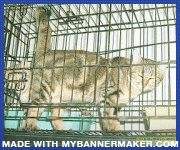Assalamualaikum........
Treating Head Tilt (Torticollis)
by Dana M. Krempels, Ph.D.
What exactly is "head tilt?" The condition medically known as torticollis (which is Latin for "twisted neck") and sometimes as "wryneck" causes a rabbit's head to twist over sideways. Often, torticollis is accompanied by a rapid side-to-side movement of the eyeballs (nystagmus), an indication that the bunny is suffering from dizziness/vertigo that should be treated along with the problem causing the head tilt.
Symptoms may appear very suddenly or exhibit a gradual onset, but the result is the same: a bunny is walking around with his head on "sideways." In some very severe cases, the bunny may be so disoriented that he simply cannot walk, and spends much of the time rolling sideways in a wild attempt to regain his footing. This is most distressing to the human caregiver, and far too many a bunny with head tilt has become the victim of his caregivers' well-meaning desire to "not let him suffer."
In truth, head tilt is usually quite treatable, though recovery may be slow. Euthanasia should be considered only as a last resort, when all attempts to cure the infection have failed, leaving the bunny in misery, unwilling to eat, drink or act normally at all. Note, however, that a permanently tilted head is not a symptom requiring euthanasia! Many rabbits with their heads tilted at a jaunty angle are living completely happy lives, running and playing with all the vigor of their straight-headed bunny pals. The most important thing is to cure the source of the head-tilt symptom. Once this is accomplished, improvement of the rabbit's posture will follow more gradually, with physical therapy and exercise.
It is not at all uncommon for symptoms of torticollis to appear very suddenly. As with almost any illness, the more rapidly the disorder is diagnosed and treated, the greater the chance for full recovery. If you do not already have a good veterinarian who is experienced with rabbit medicine, please use the House Rabbit Society veterinary referral list (linked here) to find one in your area.
Causes of Torticollis
Torticollis is not a single disease. It is a symptom of a problem with the rabbits' balance system, components of which include the central nervous system (brain and spinal cord, collectively called the "CNS"), the visual system, the vestibular apparatus in the inner ear, and even the pads of the feet, which tell the bunny he's standing on solid ground, the way gravity "intends" him to. Hence, a rabbit exhibiting torticollis may have a problem with one or more of the balance components, and causes of this include (but are not limited to)
- middle- or inner-ear infection
- parasitic infection of Encephalitozoon cuniculi in the CNS
- parasitic infestation of a nematode worm, Baylisascaris procyoni
- stroke
- abscess or tumor in the brain (intracranial abscess)
- head trauma
Most of this article will focus on what we have found to be by far the most common cause of torticollis: middle- or inner-ear infection. A shorter section at the end will address each of the other possible causes.
Ear Infection Of the causes listed, we have found that by far the most common is a middle- or inner ear infection. The Vestibular Apparatus, largely responsible for the sense of balance, is located in the bulla of the skull, a large, hollow space near the base of each ear. An ear infection can cause the tissues of the ear and inside the bulla to become inflamed, and this can interfere with proper function of the Vestibular Apparatus. A very severe inner ear infection can actually cause the bulla to fill with hard, caseous (i.e., of a tough, cheeselike texture) pus. This presses on the Vestibular Apparatus, and prevents its proper function. Any inflammation of the VA can cause head tilt.
Under the best circumstances, pus is visible inside the ear, and the vet can take a sample for culture and sensitivity testing. This will reveal (1) the species of bacteria most likely responsible for the infection and (2) the types of antibiotics most likely to kill that species/strain of bacteria. Although the most common pathogens we have seen associated with head tilt are Pseudomonas aeruginosa and Pasteurella multocida, but there are many others which also can cause this problem. Each species/strain of bacteria has its own specific sensitivity and resistance to various antibiotics. Before you throw good money after bad in a "guess" at an effective antibiotic (some vets will automatically prescribe Baytril, since it's safe--but it may not be effective against the bacteria causing the problem!), it's really best to invest in For a culture and sensitivity test if there is pus inside the ear to culture.
Once the results of the culture and sensitivity test are back, don't be surprised if your vet tries a combination of two different antibiotics to kill the bacteria. Many experienced rabbit veterinarians are now finding that combining two antibiotics is more effective at killing some of the more resistant bacteria found in rabbit ear infections. It is especially important that your veterinarian be familiar with the specific needs of rabbits in terms of antibiotics, since some of these drugs (e.g., any oral penicillins such as amoxycillin or ampicillin, and any lincosamine antibiotics) can be deadly to rabbits, even if they are commonly used on other species.
Whatever the prescription, it is vitally important that you continue to give the rabbit the full dose for the full time span your vet has indicated. Stopping the antibiotic therapy before the infection is fully gone can simply promote the selection of a resistant strain of bacteria, since those are the last ones to die off when exposed to antibiotics. If you stop the antibiotics too soon, only the most resistant ones will be left to reproduce and repopulate your poor bunny's ear!
In some cases, an ear infection appears highly resistant to the most commonly used antibiotics. A relatively recently "rediscovered" therapy that has proven highly effective in cases of head tilt, jaw abscesses and other infections of the head is treatment with bicillin, a rabbit-safe combination of injectible Penicillin-G Procaine and Benzathine. This has been used on rabbits who were deemed terminal and untreatable, and produced miraculous cures. It is something to consider if conventional antibiotic therapies are not effective.
While the antibiotics are doing their work, your vet might also prescribe other drugs to help restore balance and control the discomfort associated with vertigo. Meclizine (commercially known as Anti-Vert) is excellent for controlling dizziness, though it will not work for every rabbit. If meclizine does not control the nystagmus, your vet might prescribe a course of short-acting corticosteroids to reduce the inflammation interfering with the vestibular apparatus. We have found that these drugs can sometimes help restore normal posture even before the infection is fully cured.
It can sometimes take weeks or even months to completely cure an inner/middle ear infection. This may sound like a long time, but if supportive care is offered, and the rabbit continues to eat and drink normally and is still interested in life, it means she's not ready to give up. The condition is disorienting, but does not seem to be painful. The illness is temporary, if hard to watch, but it's worth a course of supportive care to see your bunny happy and running around again.
The results of patient nursing a bunny through torticollis can be very rewarding. I have nursed three rabbits through head tilt. Slooby's head tilt appeared very suddenly. After only fourteen days on Baytril (enrofloxacin), he was completely cured, and has not had a recurrence.
The other two, Hamish and Jamie Blue, had severe head tilts when they came to us as rescues. Jamie Blue not only had severe nystagmus; she was so disoriented that she could not stand up. She spent most of the time rolling uncontrollably, and had to be placed in a padded pen so that she would not accidentally hurt herself. Meclizine and corticosteroids helped with the immediate symptoms, but it took eight months on antibiotics to completely clear her ears of the Pseudomonas aeruginosa (which happened to be resistant to all the antibiotics tested except ciprofloxacin and colymicin) that was causing the problem.
Hamish's head tilt was also due to Pseudomonas aeruginosa, but his strain was sensitive to Baytril and aminoglycosides (e.g., amikacin, gentocin). I mention this to illustrate that randomly selecting a common antibiotic that is "usually effective" against many strains of bacteria may be a waste of time and money. A culture and sensitivity test will usually end up paying for itself in terms of time and money saved on ineffective antibiotic treatments.
Acupuncture, chiropractic treatments and massage have helped immensely with both Jamie Blue's and Hamish's head tilts. But it seems that the single most important form of physical therapy--once they stopped rolling--was regular exercise in a spacious play area where they can run in wider and wider circles, working themselves up to straight lines. Jamie Blue and Hamish both emerged from their head-tilt ordeals as happy, frolicking bunnies with a slight, residual head tilts. But even the slight tilts improved with exercise and more massage. You might be interested in a simple, but effective form of physical therapy shared with us by Larry Gavlak, who helped his bunny (Boper) regain his balance with a technique used on humans who have lost their sense of balance.
The bottom line is this: treatment for head tilt caused by an ear infection is not only possible, but often very successful. It might take a lot of patience, and a realization that rabbits do not mourn over what might have been, nor what the future might hold. If your rabbit is willing to survive the moment, is eating and drinking and showing affection, and interest in life (however dizzily), s/he deserves a chance to heal. It is so rewarding to see a head tilt bunny race and frolic like a normal bunny, even if it takes several months of treatment and love.
Encephalitozoon cuniculi
Although there is very little conclusive evidence that this microsporidian parasite--related to coccidia and to the protists that cause malaria and other serious diseases--is truly a causative agent of torticollis. However, more and more circumstantial evidence seems to support the contention that--if only in some cases of rabbits with immunosuppression--that E. cuniculi can cause head tilt and other nervous system disorders, such as hind limb paresis, general weakness, and even seizures.
E. cuniculi is apparently passed from rabbit to rabbit via cysts in the urine. The adult organisms inhabit the central nervous system and the renal (kidney) system, and rabbits with symptoms of "E. cuniculi type" head tilt (this is subtly different from that caused by infection, and is difficult to describe) often show signs of renal disease, as well. A number of excellent articles on this putative pathogen have been written, and can be accessed HERE.
At the moment, positive diagnosis can be made only upon necropsy, and even then, histological results are not always conclusive. Some vets take blood samples to send to a laboratory for titer testing, to see whether the rabbit is producing antibodies against E. cuniculi. All this test will tell the vet, however, is that the rabbit has been exposed to the organism. A high titer may indicate that there is an active infection being battled by the immune system, but such results may be interpreted differently by each professional.
Some practitioners have reported success in arresting symptoms of E. cuniculi (head tilt, hind limb paresis, renal dysfunction) with administration of the bendazole drugs (albendazole, oxibendazole, fenbendazole), which cross the blood-brain barrier and inhibit the function of tubulin, a protein vital for the parasite's feeding and infection of new cells. In a recent study, Suter, et al. (2001) reported that administration of 20mg/kg QD (once per day) of fenbendazole (which is metabolized to its active form, oxfendazole) was effective not only at preventing infection of rabbits by E. cuniculi, but also at eliminating signs of E. cuniculi infection in seropositive rabbits after four weeks of treatment. This is a promising new finding for a disease that was considered fatal and untreatable not long ago.
Baylisascaris procyoni
This is a roundworm (Phylum Nematoda) that ordinarily inhabits the intestine of raccoons. However, if other species (including humans) come into contact with eggs in raccoon waste, there is a possibility of "wrong host" infection. The larval worms migrate, not to the intestine, but to the kidneys and central nervous system, causing horrible, life-threatening problems.
At present, there is no treatment and no cure for this parasitic infection.
Central Nervous System Infections or Trauma
If head tilt is caused by a stroke or head trauma, the best one might hope to do is treat accordingly and hope that administration of appropriate anti-inflammatory drugs will help restore normal posture over time.
If the problem is believed to be caused by an intracranial abscess, with no pus to culture, then we would suggest treatment with bicillin at the outset, as this is often the only antibiotic able to cross the blood-brain barrier and be effective against many of the anaerobic bacteria that often cause such infections. In many cases, intracranial abscesses are associated with molar root infections. Because these often are caused by bacteria normally found in the intestine, antibiotic treatment can be particularly troublesome. Bicillin is one of the only drugs we have found that can combat these pathogens without entering the intestine and causing potentially life-threatening cecal dysbiosis associated with oral penicillins and lincosamine antibiotics.
Whatever the cause of your rabbit's head tilt, I hope that some of the information here will give your vet and you some leads to pursue. Many, many people have written to me before, asking about head tilt. I'm happy to say that almost every one of them has written back to say that patience, loving husbandry and the proper medicine and physical therapy had their bunnies up and running. It may have taken a week, a month, or even several months, but everyone said it was worth the work.
Suter, C., U. U. Muller-Dobles, J. M. Hatt and P. Deplazes (2001). Prevention and treatment of Encephalitozoon cuniculi in rabbits with fenbendazole. Veterinary Record 148, 478-480.















No comments:
Post a Comment